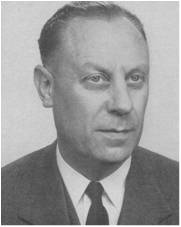Herre Rinia
- Birthdate
- 1905/03/30
- Birthplace
- Cornwerd, Netherlands
- Associated organizations
- Philips Laboratories
- Fields of study
- Television
- Awards
- IEEE Award in International Communication
Biography
Herre Rinia was born on March 30th, 1905 at Cornwerd, a small village in the northern part of the Netherlands. (His mother tongue is Frisian rather than Dutch.) He received his degree in electrical engineering in 1918 at the. Technical University of Delft, the same institution granted him an honorary doctorate in 1971, and then joined the Research Laboratories of the Philips Company at Eindhoven, where he remained until his retirement in 1966. He became a director of research in 1946.
Dr. Rinia's work touches upon a wide range of subjects in electrical, electronics and mechanical engineering. His results are laid down in a small number of publications and well over a hundred patents, but at least as important has been his influence on the work of others in the laboratories he directed. His early work at the Philips Laboratories dealt mainly with radio and he became: a specialist in designing filter coils. He next turned to television and brought the Nipkow disk to a high degree of perfection. Although for T.V. broadcasting the Nipkow disk has been superseded by electron scanning, it may reappear in certain professional applications; in any case this work helped to establish in the Philips Laboratories a tradition of high precision mechanical work. He worked on projection T.V. and devised ingenious methods for making Schmidt correction plates. A large screen colour T.V. projection system has for many years been one of the show pieces of the Eindhoven Laboratories. His work on colour T.V. comprised the design of complete equipment for the evaluation and comparison of colour T.V. systems and components and was of great importance for the development of the plumbicon camera tube. He designed a facsimile system based on mechanical scanning, which was successfully demonstrated soon after the second world war, but which never became truly operational and he considered at an early date the optical problems involved in telecommunication by light. He is the originator of the idea to rejuvenate the old Stirling cycle. This has already led to useful cryogenic equipment and may still revolutionize automotive engineering. Another example of mechanical engineering is the work of Dr. Rinia and coworkers on hydrostatic bearings. He started work on digital computers in the late forties.
Dr. Rinia was a member of the Royal Netherlands Academy of Sciences and a Fellow and past vice-president of the I.E.E.E. Subsequent to his retirement he served on several committees and governing boards. He was known among his colleagues for an astonishing collection of rules of thumb relating to nearly all branches of technology (and to many other questions besides). Through his hobbies he has obtained a remarkable competence in many crafts (he has been known to teach a cabinet maker how to use a slide: rule, in return for information on certain tricks of the trade). Dr. Rinia was married, has two sons and one daughter.
